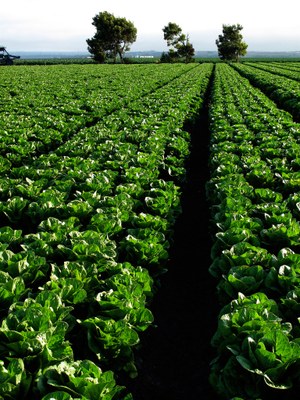Understanding the Romaine Lettuce Recall
As a horticulturist and as a mom, I have been following the romaine lettuce recall with great interest. My family and I are avid consumers of green leafy vegetables. The recall of E.coli contaminated lettuce from central coastal California has prompted more questions than answers.
A great deal of romaine lettuce is produced in central coastal California even during summer. For those of you that have grown lettuce in North Dakota, you may have experienced the challenges of growing during the summer heat. We frequently experience lettuce that bolts—it produces flowering stalks and the leaves turn bitter. This is even more problematic in head lettuces like romaine. How can California producers grow lettuce during summer without bolting? Well, the climate in central coastal California is different than we expect. While attending a summer wedding in California, we drove (and ate our way) right through the heart of this lettuce, artichoke, and Brussel sprout producing region. We landed in San Jose where the temperature was 98 deg. F. We then drove to Monterey. While the distance was only 70 miles, we watched the temperature drop by over 30 degrees within the span of an hour. This coastal area with its cool summer temperatures can grow cool season crops better than North Dakota growers during the months of June and July! Also, this region is surprisingly rural with lots of cattle ranches in addition to produce farms.
What could have caused the E. coli contamination? Nobody knows for sure at this point. The source for E. coli is fecal matter. The contamination of lettuce fields can come from multiple sources. Feral animals such as pigs, deer, and birds can deposit their feces directly on plants or on the soil. Improperly composted manure can be a source of contamination. Runoff from feedlot operations can contaminate fields or irrigation canals that supply water. The previous spring 2018 E. coli outbreak on romaine was traced to an irrigation canal that ran adjacent to a feedlot near Yuma, AZ. However, the causal connection for that outbreak was not definitively proved. The Yuma outbreak may have been exacerbated by plant stress from a frost coupled with high winds that may have spread dust contaminated with the E. coli pathogen.
The horticulture industry is rightly concerned about the safety of the produce they produce. As we head into the future, expect more pre-harvest regulations concerning buffer zones between feed lots and lettuce production fields. In addition, water quality of irrigation water may be more tightly regulated. Even the composting process for manure is being scrutinized. Post-harvest, we may see more traceability of product back to the source and the ability to implement recalls much sooner.
Can you as a consumer wash or surface-sterilize lettuce leaves to mitigate potential contamination? That may be a better question for our Food and Nutrition Specialist, Julie Garden-Robinson. I would fully expect her to advocate thorough washing of all produce as a matter of practice. However, washing or even surface-sterilization of contaminated lettuce leaves may not be enough. Recent studies show that bacteria such as Salmonella, E. coli, and Listeria can be internalized into plant tissue in certain situations. Washing or surface-sterilization cannot help in that situation.
Finally, are romaine lettuce heads more susceptible to contamination than other types of greens? From a logical point of view, it makes sense that tight heads of lettuce such as iceberg might be a little more protected. In addition, people can discard the outer leaves of iceberg lettuce if they are worried about contamination. Romaine lettuce heads are much more open and loose than iceberg heads. More scientific studies are needed to determine whether romaine is more susceptible to contamination than other types of lettuces.
The general public may be concerned that frequent recalls are a sign that the industry is unsafe. The converse may be true. In the past, foodborne outbreaks may not have been discovered. Now with the advent of DNA analysis, we can more quickly find an ongoing outbreak and institute a recall before more people get sick.
As a mom, I will continue to serve romaine lettuce on my dinner table once the foodborne outbreak is deemed finished. I have faith that the horticulture industry and the government are working hard to improve food safety of our produce.
Here are a few food safety tips from Julie Garden-Robinson:
- At the store, keep fresh fruits and vegetables away from fresh meats. Place meats in the plastic bag available in many stores, and keep in separate areas of your cart. Place vegetables and fresh meat in separate bags to take home.
- Before preparing food, wash your hands thoroughly for at least 20 seconds with plenty of soap and warm water.
- Cut away bruised or damaged portions of produce.
- Rinse fruits and vegetables under cool running water (no soap) before cutting and preparing for recipes. However, ready-to-eat bagged lettuce does not need to be re-rinsed. Use a produce brush to scrub the exterior of fruits such as cantaloupe.






